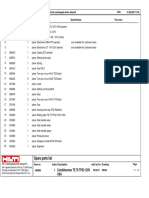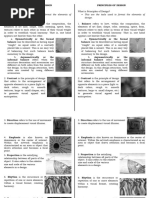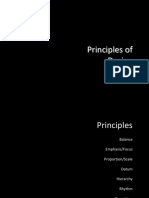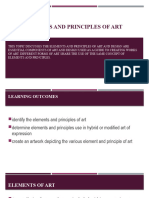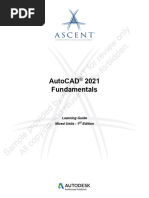Tle 7-Module 5
Tle 7-Module 5
Uploaded by
CZARINA BEA VILLANUEVACopyright:
Available Formats
Tle 7-Module 5
Tle 7-Module 5
Uploaded by
CZARINA BEA VILLANUEVAOriginal Title
Copyright
Available Formats
Share this document
Did you find this document useful?
Is this content inappropriate?
Copyright:
Available Formats
Tle 7-Module 5
Tle 7-Module 5
Uploaded by
CZARINA BEA VILLANUEVACopyright:
Available Formats
TLE 7 – DRESSMAKING (MODULE 5)
EMPHASIS – every pleasing design has one part that
Principles of Design is more interesting than any other. This is the
emphasis or the center of interest.
The principles of designs are concepts used to
organize or arrange the structural elements of
design. These are the ways in which it affects the
expressive content, or the message of the work.
BALANCE – To achieve balance, a garment or
ensemble should have equal visual weight
throughout the design.
Two types of balance:
RHYTHM – these are smooth movement repeated.
1. Symmetrically or the formal balance - can be Rhythm is an important principle of art. It is created
described as having equal "weight" on equal sides of by repeated use of the design. If there is rhythm in a
a centrally placed like a see saw. This is an easy way design, the eye would move easily from one part to
of balancing, but such balance lends monotony to the other.
the design.
2. Asymmetrically or the informal balance –Informal
balance occurs when an object appears unequal by
repetition in an arrangement of elements of design.
HARMONY - means a relationship of different
portion of a design. Harmony should be achieved
through pleasing use of color, shape, and texture to
give a feeling of oneness.
SYMMETRICAL ASYMMETRICAL
3. Radial Balance – all points of the lines meet at the
center.
ACTIVITY 1
Match column A with column B.
Column A Column B
_____1. These are the smooth
movement repeated a. proportion
PROPORTION - is the pleasing relationship of all parts to create a pattern. b. balance
of the object with one another. Proportion refers to _____2. In this principle both c. rhythm
the relative size and scale of the various elements in the left and right part of a design d. emphasis
a design. The issue is the relationship between when slice in half is equal in e. harmony
objects, or parts, of a whole. shape, color, or patterns.
_____3. This principle means the
relationship of different portion in a design.
_____4. This refers to the relative size and scale of
the various elements in a design.
_____5. Every pleasing design has one part that
is more interesting than any other.
You might also like
- Unit 1 Purva Swadhyaya Bhakti VaibhavaDocument17 pagesUnit 1 Purva Swadhyaya Bhakti Vaibhavaranjanijps83% (12)
- Hilti Te70 PDFDocument13 pagesHilti Te70 PDFSIVARAMANJAGANATHAN50% (2)
- Year 11 Textiles NotesDocument4 pagesYear 11 Textiles NotesitsanntranNo ratings yet
- Principles of DesignDocument11 pagesPrinciples of Designchristinegan38No ratings yet
- Create Design For A Simple ProjectDocument25 pagesCreate Design For A Simple ProjectTangonan DarrelNo ratings yet
- Information Sheets About The Principles of DesignDocument10 pagesInformation Sheets About The Principles of DesignMaria Noelie PerezNo ratings yet
- PRINCIPLES OF D-WPS OfficeDocument6 pagesPRINCIPLES OF D-WPS OfficeR'sel AbbigatNo ratings yet
- Principles of Art and DesignDocument27 pagesPrinciples of Art and DesignVhan Clifford PaduaNo ratings yet
- Principles of Art DesignDocument3 pagesPrinciples of Art DesignMarvin AmparoNo ratings yet
- Design Fundamentals Assignment: Name-Himanshi Gahlot FP-1 SEM-2Document12 pagesDesign Fundamentals Assignment: Name-Himanshi Gahlot FP-1 SEM-2HimanshiNo ratings yet
- Discovering The Principles of DesignDocument5 pagesDiscovering The Principles of DesignJR Cavite RachoNo ratings yet
- T.L.E. 8 Week 3-4Document7 pagesT.L.E. 8 Week 3-4meautumn83No ratings yet
- Dressmaking NCII - Week 1 and 2Document21 pagesDressmaking NCII - Week 1 and 2Jamaica Mae PaguiriganNo ratings yet
- Art Appreciation Module Week7Document11 pagesArt Appreciation Module Week7Lorraine SumaldeNo ratings yet
- Arta Finals TransesDocument1 pageArta Finals TranseswooziwaegNo ratings yet
- MODULE 4 (A)Document2 pagesMODULE 4 (A)Antonio A. Escuadra, Jr.No ratings yet
- Unit 6: Principles of DesignDocument35 pagesUnit 6: Principles of DesignZeeyaNo ratings yet
- Principles of DesignDocument10 pagesPrinciples of DesignMaria MarieNo ratings yet
- ART APP Reviewer - Lesson 5Document2 pagesART APP Reviewer - Lesson 5ArcCoronaNo ratings yet
- Art Appreciation ReportDocument31 pagesArt Appreciation Reportcherrylen etchonNo ratings yet
- CHAPTER 4: The Principles of Art DesignDocument8 pagesCHAPTER 4: The Principles of Art DesignMaria Cristina Importante100% (1)
- Q4 LAS Arts6 Wk-1-4 FinalDocument15 pagesQ4 LAS Arts6 Wk-1-4 FinalClarissa InomisNo ratings yet
- Tle 7Document30 pagesTle 7Gracielle Ann BurtonNo ratings yet
- Module Week 7 Gec008 Art AppreciationDocument5 pagesModule Week 7 Gec008 Art AppreciationJohn Mark EstrellonNo ratings yet
- Module 4 - 5 in TLE 7Document11 pagesModule 4 - 5 in TLE 7CBD COLLEGE INCNo ratings yet
- Principles of DesignDocument64 pagesPrinciples of DesignaamodpanshikarNo ratings yet
- Arts q4Document28 pagesArts q4arminaNo ratings yet
- Principles of DesignDocument2 pagesPrinciples of Designjane barquinNo ratings yet
- Inbound 4337808765886358125Document27 pagesInbound 4337808765886358125Cherry EjudoNo ratings yet
- PrincipleDocument3 pagesPrincipleghustbbbeNo ratings yet
- Quarter 3 Week 5 and 6 FinalDocument11 pagesQuarter 3 Week 5 and 6 FinalJD SevillaNo ratings yet
- Principles of DesignDocument24 pagesPrinciples of DesignSunil JaglanNo ratings yet
- Department of Education: I. Learning Competency/ Unit of CompetencyDocument4 pagesDepartment of Education: I. Learning Competency/ Unit of CompetencyBlash LeeNo ratings yet
- Elements of ArtDocument2 pagesElements of ArtCrisnalyn AnascoNo ratings yet
- TLE HE DR7-8 w5Document4 pagesTLE HE DR7-8 w5Ma Luz Dela Cruz - OmanioNo ratings yet
- Principles of DesignDocument2 pagesPrinciples of DesignElena MuyaNo ratings yet
- Design Elements PrinciplesDocument16 pagesDesign Elements PrinciplesLevy SorianoNo ratings yet
- Assessment 2.2Document3 pagesAssessment 2.2Jemarie LagadoNo ratings yet
- Post Test in Hele 7Document1 pagePost Test in Hele 7CBD COLLEGE INCNo ratings yet
- The Principles of Art Design 150823084224 Lva1 App6891Document55 pagesThe Principles of Art Design 150823084224 Lva1 App6891kathleenNo ratings yet
- Part A - FinalDocument12 pagesPart A - FinalRhealyn RobledoNo ratings yet
- Sem 8TH Theory of ArchitectureDocument21 pagesSem 8TH Theory of ArchitecturemujjuNo ratings yet
- Ilovepdf MergedDocument88 pagesIlovepdf Mergedsetolentino6487qcNo ratings yet
- LP W5 DM Principles of Design and ColorDocument6 pagesLP W5 DM Principles of Design and ColorRAYMOND GUTLAYNo ratings yet
- G DDocument5 pagesG Dmalaikairfan008No ratings yet
- Principles of DesignDocument21 pagesPrinciples of DesignLaurenceFabialaNo ratings yet
- Imaging and Design For The Online EnvironmentDocument4 pagesImaging and Design For The Online EnvironmentJelou LumakinNo ratings yet
- Elements and Principles of Art ReviewerDocument7 pagesElements and Principles of Art Revieweralvaradomichael890No ratings yet
- Topic 4Document24 pagesTopic 4ireliaakali007No ratings yet
- Interior Design Assignment 1: BY, S. DivyaDocument11 pagesInterior Design Assignment 1: BY, S. DivyaSaawan ShaikNo ratings yet
- Principles of DesignDocument14 pagesPrinciples of DesignAngel Rey LaysonNo ratings yet
- DES XI Notes -Principles of DesignDocument6 pagesDES XI Notes -Principles of Designyashika2009sindhupremanNo ratings yet
- The Elements and Principles of DesignDocument25 pagesThe Elements and Principles of DesigneloiseNo ratings yet
- Principles of DesignDocument12 pagesPrinciples of DesignRachana GoliNo ratings yet
- LASWeek 5 Output 1Document2 pagesLASWeek 5 Output 1SHIELA PANARESNo ratings yet
- Art 10 Module 1Document17 pagesArt 10 Module 1Kate BatacNo ratings yet
- Chapter 4Document4 pagesChapter 4Jim Boy BumalinNo ratings yet
- Q2 Visual Information and MediaDocument5 pagesQ2 Visual Information and MediaAngelene AmbataliNo ratings yet
- Principles of DesignDocument20 pagesPrinciples of DesignCarmela LucilleNo ratings yet
- Principles of ArtDocument1 pagePrinciples of ArtJULIUS MIRANDANo ratings yet
- Laguna State Polytechnic University: Republic of The PhilippinesDocument3 pagesLaguna State Polytechnic University: Republic of The PhilippinesJirah LacbayNo ratings yet
- Applied Design for Printers A Handbook of the Principles of Arrangement, with Brief Comment on the Periods of Design Which Have Most Strongly Influenced Printing Typographic Technical Series for Apprentices #43From EverandApplied Design for Printers A Handbook of the Principles of Arrangement, with Brief Comment on the Periods of Design Which Have Most Strongly Influenced Printing Typographic Technical Series for Apprentices #43Rating: 4 out of 5 stars4/5 (1)
- I Believe in You and MeDocument8 pagesI Believe in You and Mea478458188No ratings yet
- Central Dogma of Biology: DNA RNA ProteinDocument20 pagesCentral Dogma of Biology: DNA RNA Proteinjohn paul.jaisonNo ratings yet
- Xerox PPTDocument26 pagesXerox PPTDipti KumarNo ratings yet
- Autocad 2021 FundamentalsDocument72 pagesAutocad 2021 Fundamentalsabd devNo ratings yet
- Pseudo Science PDFDocument44 pagesPseudo Science PDFMariamiNo ratings yet
- 3 Bowden vs. BowdenDocument12 pages3 Bowden vs. BowdenMiss JNo ratings yet
- Ingles Modulo 2 BDocument26 pagesIngles Modulo 2 BANDRES ZAFRANo ratings yet
- Blessed Days of Anaesthesia: How Anaesthetics Changed The World. 1st Edition. ISBN 0192805894, 978-0192805898Document23 pagesBlessed Days of Anaesthesia: How Anaesthetics Changed The World. 1st Edition. ISBN 0192805894, 978-0192805898gwennethnevlinc100% (12)
- B2B E-Commerce in Evolution ReportDocument27 pagesB2B E-Commerce in Evolution ReportFábio Henrique AraújoNo ratings yet
- Music in FilmsDocument44 pagesMusic in FilmsprzegorzgotockiNo ratings yet
- Software ArchitectureDocument1 pageSoftware ArchitecturepgaldamezNo ratings yet
- Problem Book in High School Mathematics With Solution - TextDocument280 pagesProblem Book in High School Mathematics With Solution - TextPriyanshu SinghNo ratings yet
- Lesson 11 Power and Efficiency: OverviewDocument5 pagesLesson 11 Power and Efficiency: OverviewNadjer C. AdamNo ratings yet
- Topic 6 Elasticity and Its Application QuestionDocument8 pagesTopic 6 Elasticity and Its Application QuestionMIN ENNo ratings yet
- Annotated Bibliography For MotorsportsDocument7 pagesAnnotated Bibliography For Motorsportsapi-283793172No ratings yet
- How To Generate Content Ideas For BlogDocument17 pagesHow To Generate Content Ideas For BlogNarrato SocialNo ratings yet
- Granville Sharp BakerDocument5 pagesGranville Sharp BakerPeter PinyolNo ratings yet
- Lamps Light Madness and Sanity Rules v2Document18 pagesLamps Light Madness and Sanity Rules v2Derrick BergeronNo ratings yet
- CHEN2000 FinalDocument10 pagesCHEN2000 FinalKHÁNH VÂN DIỆPNo ratings yet
- Immediate download Gardening With the Goddess Creating Gardens of Spirit and Magick Patricia Telesco ebooks 2024Document77 pagesImmediate download Gardening With the Goddess Creating Gardens of Spirit and Magick Patricia Telesco ebooks 2024risergreamuu100% (4)
- Approach in Clinical Dermatology (Notes)Document4 pagesApproach in Clinical Dermatology (Notes)Codillia CheongNo ratings yet
- KSH International Continuously Transposed Cables - Conductors (CTC) BrochureDocument4 pagesKSH International Continuously Transposed Cables - Conductors (CTC) Brochurekshintl100% (3)
- CombinationDocument31 pagesCombinationHONEY JEAN SUPITERNo ratings yet
- Solar Radiation in MálagaDocument2 pagesSolar Radiation in MálagarodheramNo ratings yet
- Engineering Graphics - Lecture Notes, Study Material and Important Questions, AnswersDocument3 pagesEngineering Graphics - Lecture Notes, Study Material and Important Questions, AnswersM.V. TVNo ratings yet
- I Vow To Thee My CountryDocument1 pageI Vow To Thee My CountryAdamson25No ratings yet
- Body and Machine in Classical AntiquityDocument347 pagesBody and Machine in Classical AntiquityEnrique García100% (1)
- Children's Understanding of Death at Different AgesDocument2 pagesChildren's Understanding of Death at Different AgesjoNo ratings yet

